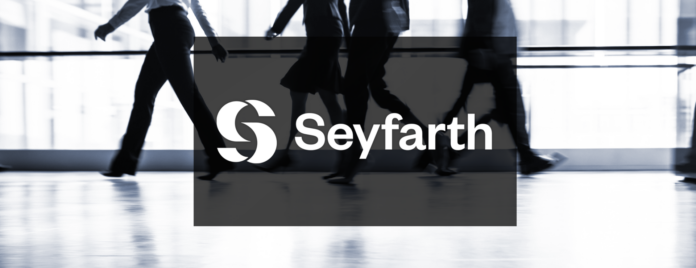Seyfarth Shaw grew revenue about 3% in 2023 despite a decline in transaction activity and plans growth through new practices, locations and artificial intelligence applications.
The firm’s profits per equity partner also increased in 2023, though by a lower percentage than revenue as the firm grew its ranks, said Lorie Almon, the firm’s chair and managing partner, in an interview. Seyfarth added 22 partners in the last 13 months, she said.
The additions are “giving us strength and depth in particular industries, particular geographies,” Almon said. “In the long run, we think that’s great for our clients and great for our partnership.”
Seyfarth, founded in Chicago in 1945 and originally focused on labor and employment law, has expanded into litigation, real estate, and transactional work, among other areas. The firm in September opened its 18th office globally in Dallas with a team of real estate lawyers and litigators from Bryan Cave Leighton Paisner.
The 931-lawyer firm brought in $855.9 million in revenue in 2022, according to figures reported by the American Lawyer. New York-based Almon, who took over as Seyfarth’s chair in late 2023, is the firm’s first female leader in its 77-year history.
Growth has been on the Chicago-founded firm’s agenda. Seyfarth launched a restructuring and insolvency group last month with a pair of partners from Bryan Cave.
Earlier this week, it added Gary Friedman, the former head of Weil Gotshal & Manges’ employment litigation group, to launch a new cross-practice advisory group that sits at the nexus of labor and employment law and complex commercial litigation.
A large-scale merger isn’t on the table for Seyfarth, but the firm is intent upon growing through partner and team additions, Almon said. It is also eyeing Florida as another place for growth given the relocation of financial companies to the Sunshine state. London, which has recently seen a number of high-profile lateral hires among Big Law firms, is also a key target for the firm.
Back stateside, the firm—like its Big Law peers—has had to determine where it lands on associate compensation after another round of increases by Milbank and Cravath Swaine & Moore sees top law firms paying between $215,000 for first-years to $435,000 for senior associates.
Seyfarth did not outright match the Milbank and Cravath salary raises, Almon said. The firm instead opted for $20,000 raises this week for all associates with no changes to its billable hours requirement.
“We’re not a firm that has the rate structure of a Milbank,” Almon said. “What we’re trying to do with our compensation is thread the needle perfectly between attracting and maintaining the top talent and having rates that are fair to our clients in the areas where we practice,” she said.
Labor in ‘Boardroom’
Seyfarth’s labor and employment practices have thrived over the last year and will likely continue into 2024 thanks to union activity, Almon said.
“Labor and employment has maybe moved from being exclusively the domain of HR personnel to being a boardroom issue,” she said. “That ability to navigate sophisticated complex, high level, labor and employment issues is going to be a really important part of any labor and employment practice right now.”
Corporations are also having to contend with the advent of generative AI and are already seeking advice on how to manage it, Almon said.
The generative AI market is poised to explode from $40 billion in 2022 to $1.3 trillion over the next decade thanks to the influx of consumer generative AI programs like OpenAI’s ChatGPT and Google’s Bard, according to Bloomberg Intelligence.
For Seyfarth, this presents opportunities both on the client end as well as within the law firm itself to leverage its long-standing knowledge in the space. About 12 years ago, the firm created Seyfarth Labs, a team of programmers and engineers with legal backgrounds that have been helping the firm think about and understand AI, Almon said.
“Our intention is not to sit back and wait, it’s to absolutely be at the forefront,” she said.
AI Navigation
The firm is already helping clients in navigating AI, particularly in the employment space, but also in real estate around tenancy and leases, Almon said.
Friedman, the firm’s most recent addition from Weil Gotshal, testified before the Equal Employment Opportunity Commission last month on how to navigate employment discrimination in AI.
On the law firm side, Almon said the firm is thinking about ways to use AI that would enhance quality and efficiency to make sure attorneys are delivering the best possible work.
“We want to attract and develop and retain the best possible legal talent and teach them to be practical and bright and deeply knowledgeable about their industry,” Almon said. “But we want to use innovation in AI to ensure everything we’re doing is the highest quality, that we’re not taking time that doesn’t need to be taken by a human being.”
That might mean taking advantage of AI’s ability to pull knowledge from a mass of databases and put it into clients’ hands or looking at trends, statistics and analytics and having that inform decisions, she said.
“A human being can’t possibly digest as much information as AI so if you pair the human and the AI’s ability to synthesize enormous amounts of data, I think you’re going to give your client a better product,” Almon said.
But that change isn’t going to happen overnight.
“It’s going to transform our industry and what we do, I really do, not today, but maybe two years from now,” Almon said.
